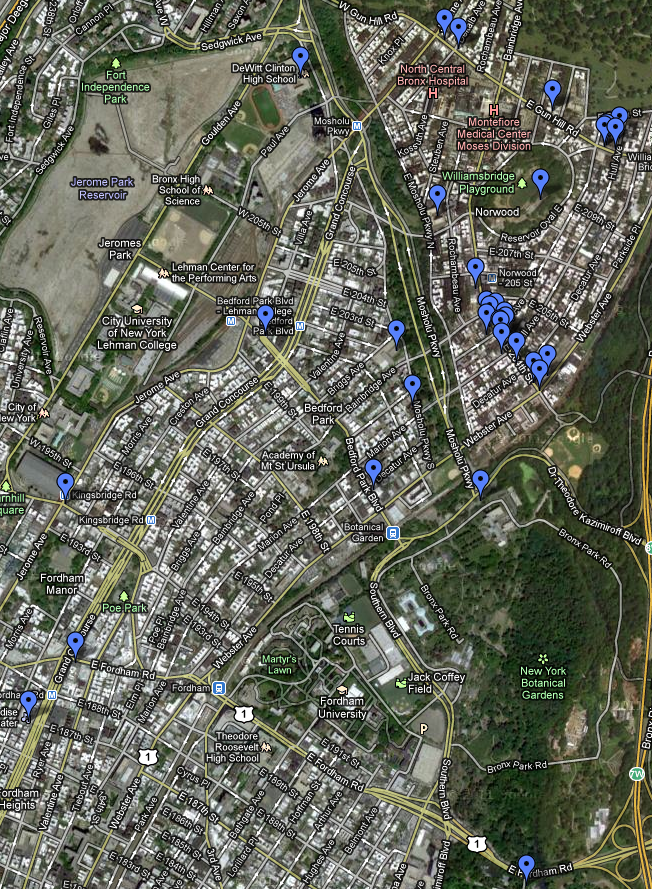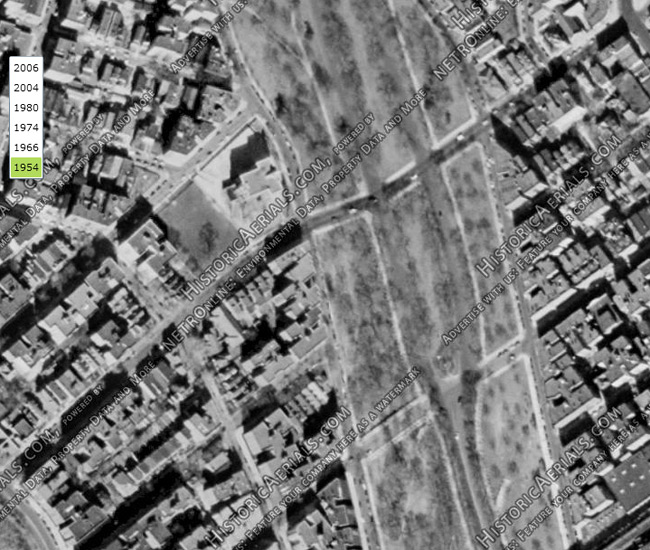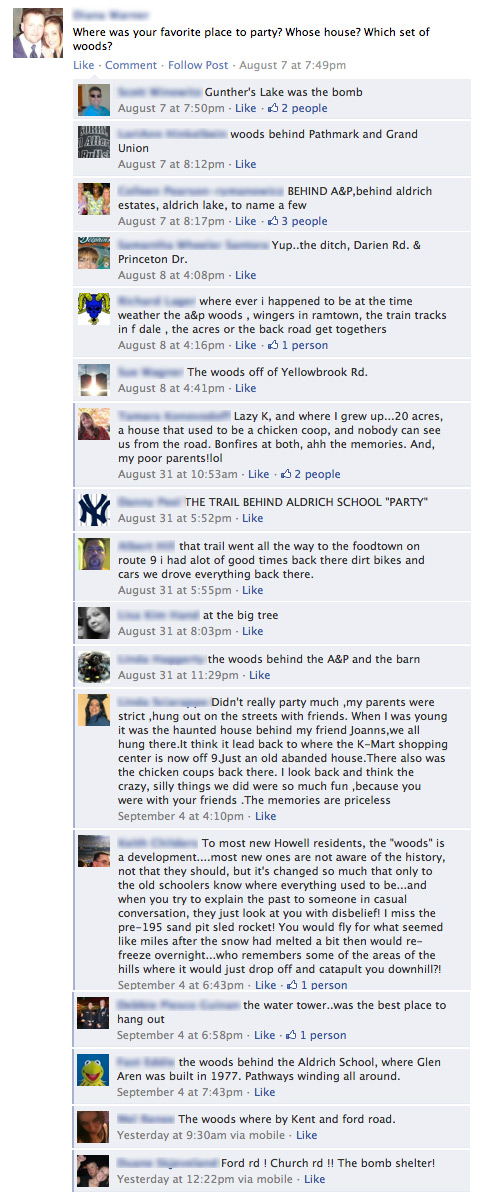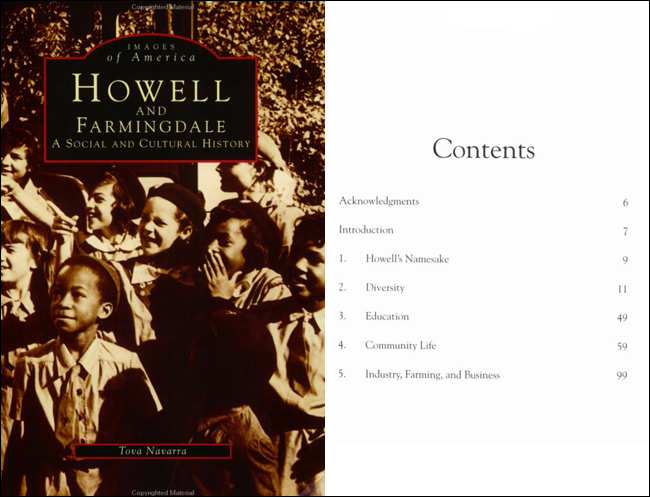The blue pins on this map encapsulates my dad’s childhood in the 1940s and 50s from birth to age 18:

Each pin marks a significant place: where he played stickball; where he had his first haircut; where he learned to ride his bike; where he walked with his dad each night to pick up the early edition of the next day’s newspaper.
And in some ways, we can peek into that past: this is an aerial view of my Dad’s neighborhood from 1954, when he would have been in High School:

(image via HistoricAerials.com)
I have been obsessed with how we capture and share the stories of our lives. I have written posts in the past about how I have leveraged Facebook to share photos of places in the town I grew up in, and was amazed at how people provided the context. Likewise, another post about someone who is preserving the history of an entire town that disappeared from the face of the planet.
New resources keep popping up, such as a new Facebook Group where people from the town I grew up in share their experiences living there. It has become an amazing historical record of STORIES and EXPERIENCES. The types of things that no book can create a record of, such as this question and answer series: “Where was your favorite place to party? Whose house? Which set of woods?” where people describe the ditches, patches of woods, train tracks and dirt trails that made up their best experiences growing up. Read through some of the responses, you can sense the meaning that these places had to each person, and yet, the places they describe are not landmarks you can easily mark on a map:

Many of these places are long gone, now housing developments and strip malls. In a way, this is an oral history, the legends that exist in the minds of kids and adults, as the world whisks past us.
but…
I am finding that theses tools to capture the stories of our lives are both AMAZING and LIMITING.
They allow us to share, but the information is quickly lost in untagged, unorganized status update threads from weeks or months ago. Systems such as Facebook are built for the moment, not for archival purposes. You see the same question asked again and again, weeks apart. You see parts of a story in one comment thread, and another part somewhere else in a photo comment. And this is even within the same platform – it does nothing to bring in photos or commentary from other sources.
There are books about the history of my town. Here is one of them:

As you can see, there is no chapter titled “Ditches that kids partied in in 1986.” Perhaps you are thinking that this is irrelevant, that there is no point in preserving this type of history. For me, this is the REAL story of our lives. The little things that are meaningful beyond compare. The types of memories that we covet – not the facts and figures, but the moments of our very presence in certain places, at certain times, with certain people. The things that seem insignificant, but characterize the depth of our experience as human beings. Small stories – of places that “don’t matter” to the larger world, but mattered incredibly in our lives.
Yes, the book above likely crafts a wonderful narrative, sharing a combination of facts and stories that embody a general view of the place I grew up. And it is something extremely valuable, plus it preserves these things far better than Facebook does. But a book such as this misses out on some of the value that social media provides:
- It can’t evolve, constantly adding more and more detail and context to the story, as social media can provide.
- Individuals can’t share their own story of a time or place.
- You don’t get the FEELING of places or individuals. Maybe it mentions a well-known proprietor of a local bar, but it doesn’t tell you the funny stories or give you people’s memories of him.
- It doesn’t integrate well with multiple ways of experiencing the same place or time, perhaps through maps or photos.
- It is limited by one view of one time or place. The story doesn’t keep adding the experiences of the next generation. It doesn’t speak to those who went to High School there in 1986 as different than those who went to High School there in 1991.
- It doesn’t invite us all to contribute, regardless of who we are. We are told the story, not allowed to become a part of it.
With the limits I am finding in existing social networks, I am desperately looking for a tool to capture, organize and preserve these stories. If you know of one, please let me know. I am looking for much of what Facebook has delivered, but with a way to link pieces to a larger narrative; to tag it to a map; align to a timeline; aggregate photos and stories and videos; and include attribution to individual contributors. And maybe even a way to place a “call for information” so if we are missing the piece of the puzzle, we can crowdsource the answer. And of course, a place where we can truly archive this material, and make it easy to access.
And if I don’t find the tool I need, I may just have to build it.
Reading through that list of “party spots” from my home town again, it makes you realize that the places, the times, the events that matter were not what we most commonly share: where we went to college, where we worked, what our job titles and accomplishments were. But those ditches, patches of woods, trails, train tracks, and trees that somehow made up our lives. Those silly unstructured moments with no purpose other than to be present.
Thanks!
-Dan
